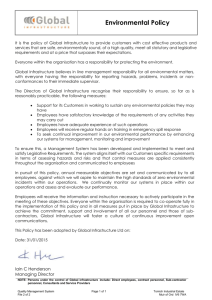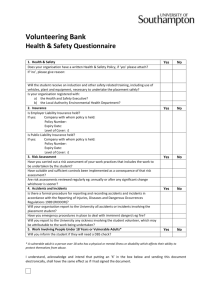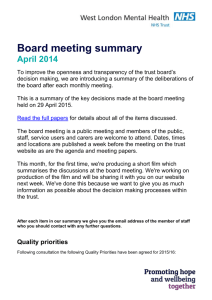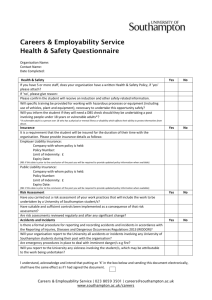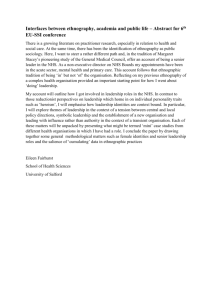here - NHS Education for Scotland
advertisement
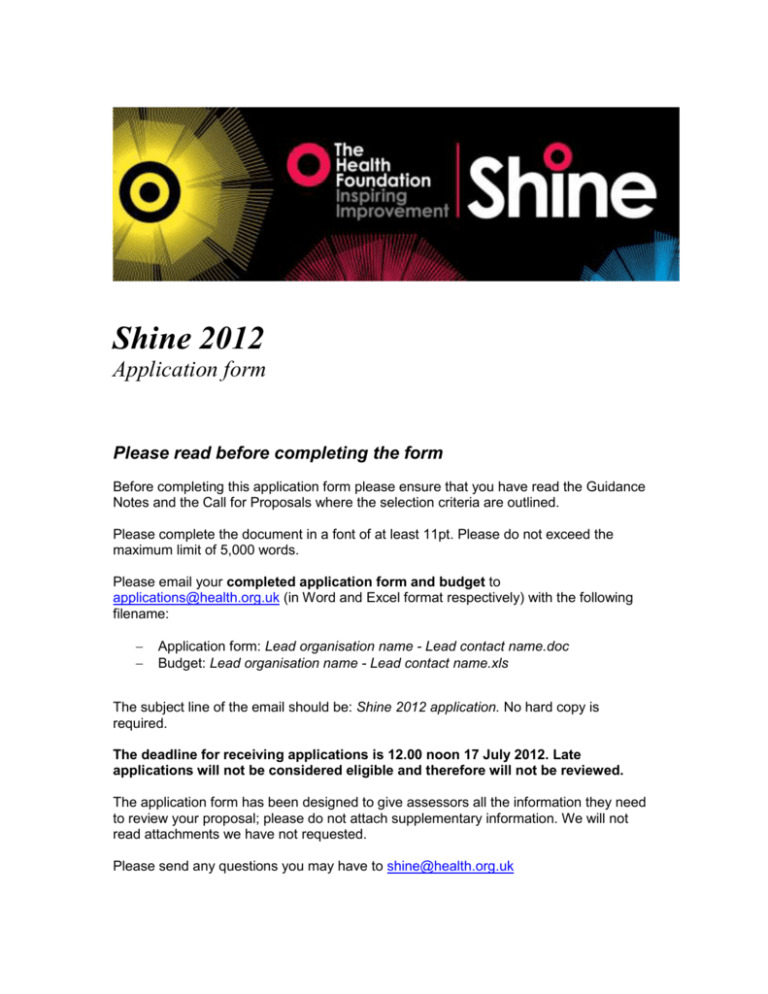
Shine 2012 Application form Please read before completing the form Before completing this application form please ensure that you have read the Guidance Notes and the Call for Proposals where the selection criteria are outlined. Please complete the document in a font of at least 11pt. Please do not exceed the maximum limit of 5,000 words. Please email your completed application form and budget to applications@health.org.uk (in Word and Excel format respectively) with the following filename: Application form: Lead organisation name - Lead contact name.doc Budget: Lead organisation name - Lead contact name.xls The subject line of the email should be: Shine 2012 application. No hard copy is required. The deadline for receiving applications is 12.00 noon 17 July 2012. Late applications will not be considered eligible and therefore will not be reviewed. The application form has been designed to give assessors all the information they need to review your proposal; please do not attach supplementary information. We will not read attachments we have not requested. Please send any questions you may have to shine@health.org.uk 1. Summary This section provides the Health Foundation and assessors with key information about your project at a glance. 1.1 Lead organisation Organisation name NHS Education for Scotland (NES) Type of organisation Special Health Authority Registered address 2nd Floor, Hanover Buildings 66 Rose Street Edinburgh EH2 2NN The application should be led by the organisation where the innovation is being tested. This is also the organisation with whom we will contract should the proposal be successful. This organisation will receive the funding from the Health Foundation and will be expected to manage the budget and distribute it among the partner organisations through local agreements as required. Please tell us what type of organisation this is, for example a voluntary organisation or NHS body. 1.2 Primary contact for this proposal Full name and title Dr Paul Bowie Job title R&D Lead for Safety & Improvement Office/contact address NHS Education for Scotland, 2 Central Quay, 89 Hydepark Street, Glasgow, UK G3 8BW Email paul.bowie@nes.scot.nhs.uk Telephone 0141 223 1463 Alternative contact name Mrs June Morrison ( e.g. PA) if applicable Alternative contact email june.morrison@nes.scot.nhs.uk Alternative contact 0141 223 1450 telephone number You should name a person from within the lead organisation who will be the project’s primary contact. This should be the person whom the Health Foundation can contact if we require further information or clarification throughout the assessment period and preferably the duration of the project. 1.3 Project title *Addressing the emotional barriers hindering the constructive investigation of patient safety incidents and promoting a human factors framework to facilitate indepth analysis in primary care Please indicate a title that briefly explains the overall aims of your project (25 words maximum). *We are aware from the teleconference call that the Health Foundation may give greater priority to innovative safety improvement ideas which are more ‘proactive’ than ‘reactive’ in nature. However, we would argue strongly that important socio-cultural and behavioural step changes are necessary before many health care professionals feel empowered enough to proactively engage in patient safety initiatives (rather than react – if at all, or to a sub-optimal standard – when something goes wrong). For most clinicians, their first (and possibly only) interaction in learning from error and systemsfailure will be via team-based educational techniques such as significant event analysis. However, there are numerous deep-seated problems involving diverse but interrelated factors such as the NHS blame culture, individual emotional reactions to disclosure of incidents and the subsequent standard of incident investigations which need to be the focus of improvement efforts before clinicians are psychologically ready to take the next step and engage more explicitly and proactively with the patient safety agenda. 1.4 Abstract The problem The limited evidence base suggests that between 1 and 2% of clinical consultations with patients in primary care may contain an adverse event (The Health Foundation, 2011a). Given that there are around 1 million consultations in UK primary care every day, it is clear that the potential scale of the problem is of great concern to all. However, there is strong evidence to suggest that many team-based investigations into patient safety incidents in primary care are poorly conducted (McKay et al, 2009; Bowie et al, 2008). Two key issues contribute. First, the emotional reaction to negative feedback can interfere with the ability to assimilate and process the information beyond the ‘self’ level (Kluger & De Nisi, 1996) and thereby potentially impede an objective and constructive approach to patient safety incidents. We also know that primary care clinicians are highly selective in the types of safety incidents they highlight for team-based discussion and analysis (Bowie et al, 2005a). Second, practitioners lack a structured analytical framework that can be used by primary care teams when analysing patent safety incidents. Although there is strong engagement with SEA in primary care, the evidence for its impact on improving the quality and safety of patient care is limited. There is now good evidence to suggest that the standard of reflection and critical analyses of such events is poor in a substantial proportion of SEAs undertaken by primary healthcare teams with most lacking a necessary understanding of the human and systems-based factors underpinning these incidents. While basic guidance has been published, a theory-informed framework to strengthen and guide the processes by which healthcare professionals can analyse patient safety incidents more effectively is clearly lacking. Consequently there are multiple implications associated with what is highly likely to be a routine everyday occurrence in UK primary care settings, including: numerous missed opportunities for individual, team-based and wider organisational learning from patient safety incidents to minimise the risks of recurrence; wasted time, efforts and financial resources associated with participating in (frequently predictable) sub-optimal learning and improvement efforts; the impact on stress and sickness levels amongst the primary care workforce, not least of which is the longer term impact on the psychological well being of healthcare professionals (Sirriyey et al, 2010); and the chance to increase patient involvement in safety issues directly affecting them and, paradoxically, enhance patient satisfaction with experience of care. The proposed solution Our own extensive experiences, supported by the limited evidence base (Sirriyey et al, 2010; Scott et al, 2009; O’Beirne et al, 2012; Wu & Steckelberg, 2012), suggests a pressing need for an innovative educational intervention that can provide a structured, meaningful way for clinicians (undergoing training and trained) to disclose their errors and to forestall any negative emotional barriers and impacts in subsequent interactions with healthcare colleagues, which are often critical to the personal coping process and the standard of subsequent incident analyses by the care team. We propose, therefore, to design, develop and validate a ‘guiding tool’ to enable the individual clinician to: 1. Reflect upon and become more aware of the emotional reaction and psychological consequences associated with being part of a patient safety incident in order to achieve a state of emotional and psychological readiness to move on to the next stages – task and process levels 2. Raise awareness of the psychological barriers which operate when approaching a team-based investigation of a patient safety incident. 3. Undertake the analysis of a patient safety incident within the team by applying a human factors-based framework to differentiate the personal/individual and system levels issues at play (adapted from Flin et al, 2010 and Moray 2001). The expected benefits and outcomes 1. The Patient Improved analyses of patient safety incidents will inform more effective change and improvement and reduce risks of harm to patients Increased patient engagement will improve experience and satisfaction with the care process as a result of more explicit involvement by being made aware of an incident investigation and receiving a summary of the final learning report 2. The Individual Practitioner Redress of the blame culture will be achieved by redirecting perceptions of solely personal emotional experiences of liability/fault to a more objective systems-based approach based on human factors principles Deeper insight into the emotional response to dealing with patient safety incidents (whether directly involved or not), will engender increased understanding and empathy and the need to provide professional reaffirmation and personal reassurance to colleagues 3. The Healthcare Team Improved team dynamics will be acquired through having a positive empathic understanding of the psychological barriers affecting individuals involved in patient safety incidents and will prompt a standardised and more constructive and meaningful team-based investigation and analysis 4. The Organisation Improved interface discussion will facilitate shared learning A human factors approach by definition prompts an organisational level response - where appropriate this should impact learning and policy at a strategic level The concept of human factors will be imbued across the organisation by demonstrating its practical application to clinical care Improved sharing of incidents offers the potential to improve organisational level data via enhanced engagement in incident reporting systems Provide a summary of your project in plain English. This summary should enable a nonexpert to understand how the innovative proposal will improve quality and demonstrate an understanding of the costs and benefits associated with the intervention. You should use the headings in the text box. REFERENCES Bowie P, Pope L & Lough M (2008). A review of the current evidence base for significant event analysis. Journal of Evaluation in Clinical Practice 14 (4): 520-536 Bowie P, Halley L, Gillies J, Houston N & de Wet C (2012). Searching primary care records for predefined triggers may expose latent risks and adverse events. Clinical Risk 18:13—18; doi:10.1258/cr.2012.011055 Bowie P, McKay J, Dalgetty E, Lough M (2005a). A qualitative study of why general practitioners may participate in significant event analysis and educational peer review. Quality & Safety in Health Care 14: 185-189 Bowie P, McCoy S, McKay J, Lough M (2005b). Learning issues raised by the educational peer review of significant event analyses in general practice. Quality in Primary Care 13: 75-84 Cox S J & Holden J D (2007). A retrospective review of significant events reported in one district in 2004–2005. Br J Gen Pract. 1; 57(542): 732–736. Blamey, A., and Mackenzie, M. (2007). Theories of change and realistic evaluation: peas in a pod or apples and oranges? Evaluation, 13 (4). pp. 439-455. (doi:10.1177/1356389007082129) Bradley N, Power A, Hesselgreaves H, McMillan F and Bowie P (2009). Safer pharmacy practice: a preliminary study of significant event analysis and peer feedback. International Journal of Pharmacy Practice 17: 283–291. De Wet & Bowie P (2011). Screening electronic patient records for preventable harm: a trigger tool for primary care. Quality in Primary Care 19:115-25 De Wet C & Bowie P (2009). A preliminary study to develop and test a global trigger tool to identify undetected error and patient harm in primary care records. Postgraduate Medical Journal 85 176-180 Flin R et al (2009). Human factors in patient safety: review of topics and tools. World Health Organisation, Geneva. Ginsburg L, Castel E, Tregunno D, et al (2012). The H-PEPSS: an instrument to measure health professionals’ perceptions of patient safety competence at entry into practice. BMJ Qual Saf (2012). doi:10.1136/bmjqs-2011-000601 Kluger AN, DeNisi A. (1996). Effects of feedback intervention on performance: A historical review, a meta-analysis, and a preliminary feedback intervention theory. Psychol Bull 119(2):254-284. McKay J, Bradley N, Lough M and Bowie P (2009). A review of significant events analysed in general medical practice: implications for the quality and safety of patient care. BMC Family Practice 10:61 Moray N (2000). Culture, politics and ergonomics. Ergonomics 43;868 O’Beirne M, P Sterlin, L Palacios-Derflingber, S Hobman & K Zwicker (2012). Emotional impact of patient safety incidents on family physicians and their office staff. J Am Board Fam Med 25;177-183 The Health Foundation (2011a). Report: Improving Safety in Primary Care – Research Scan (November 2011) The Health Foundation (2011b). Report: Improvement Science - Research Scan (January 2011). Pawson R & Tilley N (1997). Realistic Evaluation. London: Sage Sargeant J, Mann K, Sinclair D, van der Vleuten C, Metsemakers J (2006). Understanding the influence of emotions and reflection upon multi-source feedback acceptance and use. Advances in Health Sciences Education DOI 10.1007/s10459-006-9039-x. Sargeant J, Mann K, van der Vleuten C, Metsemakers J. Reflection (2009): A link between receiving and using assessment feedback. Advances in Health Science Education Theory Practice, 3: 399-410. Sargeant J, McNaughton E, Mercer S, Murphy D, Sullivan P, Bruce D (2011). Providing feedback: Exploring a model (Emotion, Content, Outcomes) for facilitating multisource feedback. Medical Teacher 33(9):744-749.
